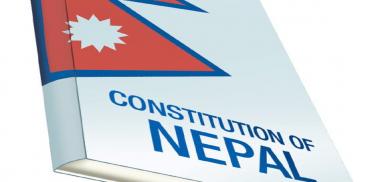Nepal’s democracy day: Time to implement constitution in letter and spirit
It’s high time for the people and the government to come together in devising a robust mechanism for the implementation of the constitutional provisions, for the republic, deserves to realize the cherished goals envisioned under the preamble, write Jivesh Jha and Dr Alok Kumar Yadav for South Asia Monitor

How can democracy be best remembered? The celebration of democracy in Nepal would have little meaning if the people living under the constitution are not made familiar with the core values enshrined in the national document. While celebrating the ‘Loktantra Divas’ this year on Baisakh 11 (April 24), there is a dire need to critically analyse the effectiveness of the constitution.
While celebrating the Loktantra Divas, which commemorates the restoration of parliament in 2006 after its dissolution by then King Gyanendra in 2005, the people should make a solemn commitment to compose their actions in accordance with the constitution which unites the population of over 30 million.
The current constitution of Nepal, the precursor of new Nepali renaissance, came into force on September 20, 2015, laying down the political structure and addressed the needs and aspirations of the citizens who are united for the purpose of resisting external intervention, upholding rule of law and preservation of the nation’s sovereignty and integrity.
The ratification of the constitution was a sign that the country had geared-up for consolidating the agenda of different political movements that took place in the state. It led to the overthrowing of a long-lasting constitutional monarchy.
Under the new constitution, Nepal has a federal structure with the country divided into seven provinces, and there is clear delineation of legislative powers for the central, provincial, and local bodies. The other main characteristic feature of the new charter is inclusiveness.
Interim Constitution
The milestone for this constitutional spirit was set by the 2007 Interim Constitution and the new document gave emphasis to the continuance of this inclusivity with certain modification in number of clusters, keeping in mind the rights of women, the disabled, sexual minorities and other oppressed group.
Paradigm shifts: Historical development of constitutional law in Nepal
Of the seven constitutions that the Himalayan country has seen, the Government of Nepal Act 1948 was the first such document. Under this Act, the ultimate sovereignty was not vested on the people of Nepal. Article 22 (a) provisioned that there shall be the Legislative Assembly of Nepal comprising His Highness Sri Teen Maharaja, the Rastra Sabha [National Assembly] and the Bharadari Sabha [Advisory Assembly].
Rana Prime Ministers thus used to present themselves like kings or the ultimate political superior or chief of the state. Interestingly, the king was not considered an essential component of parliament even though he was official head of the state.
The ministers were required to take solemn oath of office and secrecy before the Prime Minister, who also confirmed their resignation.
Second constitution
The end of the Rana regime following the 1951 revolution saw King Tribhuvan promulgating the second constitution of the Kingdom of Nepal on March 30, 1951, based on the advice of the Council of Ministers. It came into force on April 11, 1951. Nevertheless, it was a compromised document between the king, the Ranas, and the Nepali Congress.
It is to be noted that Falgun 7, 2007 BS (i.e. February 18, 1951) has been marked as the day on which democracy was established as a result of the overthrowing of the Rana oligarchy. That’s why Nepal commemorates Falgun 7 as Democracy Day.
The 1951 constitution borrowed the provisions relating to fundamental rights and directive principles of state policies from the Indian Constitution. The scholars argue that it was a replica of the Indian Constitution. However, the provision of emergency was not incorporated in the document. Like the previous constitutions, this charter too failed the test of time.
King Mahendra’s constitution
The Constitution of Kingdom of Nepal, 1959, was crafted by a committee formulated by then King Mahendra. A distinguished jurist Sir Ivor Jennings, who had served as Dean in Colombo University for long, was called upon by King Mahendra to draft the constitution
Under this constitution, the cabinet was accountable not only to the parliament, but also to the king. The king was not bound to work exclusively on the aid and advice of the Council of Ministers and had absolute power to declare emergency under Article 55. The government elected by the voters and the parliament of the day had no control over the proclamation or revocation of emergency under Article 55. Also, the King was conferred with the power to dissolve the Lower House and the government in power.
The 1959 constitution was the first highest law of the land which firmly adhered to Hindu culture and tradition. Article 5 provided that “no person shall be entitled to convert another person to his religion.”
Article 57 of the charter envisioned that the judges, including the Chief Justice, of the top court shall be appointed by His Majesty “in His discretion, after consulting the Prime Minister and some other judges of the Supreme Court as He may deem necessary.”
Mahendra’s 1962 constitution
Like the 1959 constitution, the 1962 charter too reaffirmed that Nepal shall be an independent, indivisible and sovereign Monarchical Hindu kingdom. The constitution under Article 8 provisioned that one must have knowledge of Nepali language and s/he was expected to “read and write the national language of Nepal” in order to acquire Nepali citizenship.
The constitution provisioned that a person of “Nepali origin”, who has resided in Nepal for a period of not less than two years after renouncing the citizenship of her country in the case of a female married to a Nepalese citizen, was entitled to obtain citizenship. The expression “Nepali origin” was nowhere defined under the Constitution. On the contrary, a similar approach was not adopted for the persons who did not have so called “Nepali origin.” The provision required that a woman who is married to a Nepali man and if she was not from Nepali origin then in such case, she was required to apply for citizenship after fifteen years of her stay in Nepal.
This constitution too failed to last for long due to many reasons. Of them, the regressive citizenship laws, party-less legislature and extreme emphasis on a particular language and culture could be considered the major shortcomings of this document.
A democratic constitution
The Constitution of Nepal, 1990, followed a series of development which succeeded in repealing the 1962 Constitution. The constitution was promulgated by the then His Majesty the King Birendra..
Part-2 of the Constitution details the provisions of ‘Citizenship.’ It provides that any person whose father is a descent citizen is entitled to acquire citizenship by descent. The enactment runs like this: A person who is born after the commencement of this constitution and whose father is a citizen of Nepal at the birth of the child shall be a citizen of Nepal by descent. However, it had been provisioned that a foreigner may acquire a naturalised Nepali citizenship if he resides in the country for at least fifteen years and he can speak and write the Nepali language. A foreigner woman tying the nuptial knot with a Nepali man was allowed to seek naturalised citizenship at the instance of solemnisation of marriage.
Article 4 of the constitution sought to uphold the Hindu character of the state but at the same time Article 2 provisioned that “the Nepalese people irrespective of religion, race, caste or tribe, collectively constitute the nation.”
2007 Interim Constitution
The Interim Constitution of Nepal BS 2063 (i.e., 2007) had been crafted following a political understanding developed in the aftermath of the overthrow of constitutional monarchy for an interim period till the promulgation of a new constitution by the Constituent Assembly. Nepal received its Interim Constitution and interim parliament with Maoist rebels joining mainstream politics on January 15, 2007.
Understandably, the historic 12-point agreement signed between Seven Party Alliance and CPN-Maoist laid the foundation for the election of the Constituent Assembly, and that deal was further cemented by the Comprehensive Peace Agreement (CPA) in 2006. The 12-point understanding and CPA laid the principles of new constitution that officially recognised secularism, republicanism, and pushed for federalism.
2015 constitution
A few things about the 2015 constitution are worth remembering. One, it’s the first formal constitution to affirm a federal republican democracy. Two, the conscience of the constitution has been captured under Part-III (Fundamental Rights) and Part-IV (Directive Principles). They are evidence of the splendid collection of rights, worthy of a public welfare state and envisages newly empowered citizenships.
Thirdly, Nepal has set aside 33 percent of parliamentary seats for women, which is a major breakthrough. With the enactment of new constitution, Nepal is transformed into a republican state from a Constitutional monarchy, a federal democracy from a unitary system of governance, and a secular structure from one with a Hindu character.
Having gone through the constitution, one can firmly and proudly say Nepal’s new constitution is progressive, and institutes several positive elements for the uplift of women in the country.
Like other constitutions of the world, this document too adopts progressive provisions for realising the goals of federalism. It was a prerequisite for the Himalayan Republic to come up with a fundamental document showing adherence to republicanism with strong federalism. Unlike the 1962 constitution, every person bon in Nepal is allowed to claim Nepali citizenship, irrespective of his command over Nepali language. How can we call it (Nepali constitution) a regressive charter?
Meaning of Loktantra Diwas
As action speaks louder than words, the need of the hour is to realize the provisions of the constitution. The ambitious provisions of fundamental rights would lose their charm if the state turns a deaf ear in giving effect to these provisions in a true and material sense.
Importantly, the constitution has not prevented any political group or activists from doing or refrain from doing something, which they are to do to for the welfare of their community or voters. In fact, it is unjust to blame the constitution for their failures.
Those who protested against the constitution are holding vital government offices in the Province-2 and the central government. How could they blame the constitution?
It’s high time for the people and the government to come together in devising a robust mechanism for the implementation of the constitutional provisions, for the republic deserves to realise the cherished goals envisioned under the preamble.
The celebration of Loktantra Diwas would have no meaning unless people from all walks of life compose their actions for the implementation of constitutionalism and rule of law.
(Jivesh Jha, a former law lecturer at Kathmandu University School of Law, is a Judicial Officer, Birgunj High Court, Nepal. He can be contacted at jhajivesh@gmail.com. Alok Kumar Yadav is a professor of law at HNB Garhwal University, Srinagar, Uttarakhand, India. The views are personal)









Post a Comment